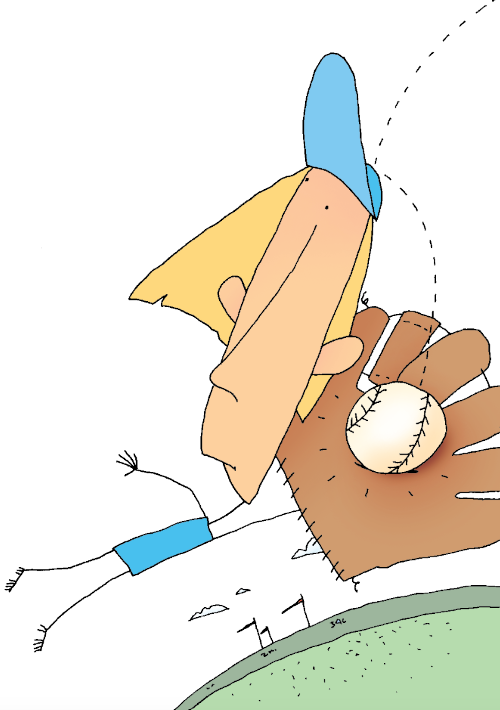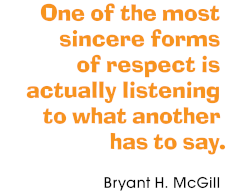WOC 435
Page 435

Listening Skills
“Heads up!” shouts the coach, pointing at the pop-fly over center field.
“I got it!” shouts the short stop, running backward to catch the ball.
“I got it!” shouts the center fielder, running forward to catch the ball.
What happens next? If everyone is listening, the players will work together to make the out. If nobody is listening, the ball will drop—or the players will.
Listening requires not just focus, but intent, as this chapter shows.
What’s Ahead
WOC 436
Page 436
Becoming a Good Listener
So how can you become a better listener, both in and out of school? To start, good listening takes practice. Next, it requires careful attention. Here’s a whole page of suggestions to help you become a better listener. Try practicing them the next time you need to listen carefully.

- Listen with a positive attitude; you’ll learn more.
- Listen with your eyes as well as your ears; you’ll hear more if you look at the speaker.
- Listen for the main ideas; you’ll stay on track.
- Listen for the speaker’s tone of voice; you’ll get the true meaning.
- Listen for specific directions; you’ll know what you’re supposed to do.
- Listen for signal words (first/second, before/after, next/then); you’ll be able to follow the speaker from one point to the next.
- Think about what you hear; you’ll understand better if you relate what you hear to what you already know.
- Know when—and how—to interrupt; you’ll be able to ask for clarification. (See the “Helpful Hint” below.)
- Review the speaker’s message; you’ll ensure you understand the main point.
Helpful Hint
When you need to interrupt a speaker to clarify a confusing or unclear point, you can raise your hand and ask, “Excuse me, could you repeat or clarify your last point?” However, wait until the speaker finishes his or her complete thought before asking for clarification.
WOC 437
Page 437
Avoiding Listening Pitfalls
When you listen, especially in groups, you will want to avoid the following bad habits or pitfalls.
■ Daydreaming
Keep your mind and ears on the person speaking, not on what you’ll be doing after school or during the weekend.
■ Becoming Emotional
Sometimes you may get distracted by what the speaker is saying. Maybe it sounds like a great idea, and you want to talk about it rather than continuing to listen. Or maybe it doesn’t sound so great, and you want to make a comment. Keep your cool and keep listening.
■ Interrupting
Sometimes it’s necessary to interrupt the speaker. Maybe you are confused and need to ask for clarification. That’s okay, but do it politely. But, if it can wait, don’t interrupt.
■ Taking Too Many Notes
Believe it or not, it’s actually possible to take too many notes. It’s important to take good notes, but that means writing down only the essential information, not every last detail.
■ Taking Too Few Notes
Just as taking too many notes is not a good idea, neither is taking too few. Sometimes listeners get so caught up in what is being said that they forget to take notes.
■ Doing Other Things
When you are supposed to be listening, give the speaker your full attention. Don’t work on another assignment when a classmate is giving a report, or draw cartoons when the teacher is giving a history lesson (unless the cartoon is about the topic).
Helpful Hint
The best advice to listeners: “Listen to others the same way you would want them to listen to you.” Sound familiar?
WOC 438
Page 438
Listening and Learning
Listening is one of your most important learning tools. But to ensure that you remember the main points of a presentation or discussion, use the information as soon as you can, and as often as you can.
Learning Through Listening
- Write in a learning log or blog. Explore your thoughts and feelings about the topic of the presentation or discussion. Push yourself to write freely for at least 5 minutes.
- Think critically about the topic by analyzing it. This means comparing it to similar ideas, describing it step by step, deciding if it is a problem or a solution, and so on.
- Think creatively about the topic by asking and answering creative questions about it: What piece of clothing is this topic like? What type of personality does it have?
- Use the information in your class work—during discussions, in assignments, and in projects. Using new information helps you remember it.
- Expand your understanding of the topic by conducting research online or by talking about it with an authority. The more you learn about it, the better.
- Talk about the topic with different audiences—friends, family members, younger kids, and so on. This will force you to explain the information several times, in different ways, which will help you remember it.
- Review the material regularly. Read over your notes and learning-log entries every week or two to help you remember the information.
- Use the information in an essay or report. Could the material be used as a topic or as supporting information for a writing assignment?